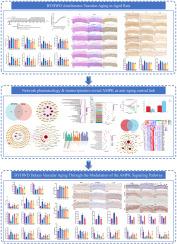Integrative network pharmacology and transcriptomics suggest the mechanism of Buyang Huanwu Decoction in attenuating vascular aging via AMPK signaling pathway
引用次数: 0
Abstract
Objective
Vascular aging is a critical factor in cardiovascular diseases. Buyang Huanwu Decoction (BYHWD), a traditional Chinese medicine, shows potential in delaying vascular aging, yet its mechanisms remain unclear. This study aims to explore BYHWD's pharmacological mechanisms through integrative network pharmacology and transcriptomics.
Methods
Network pharmacology identified BYHWD targets related to aging, followed by pathway enrichment analysis. Vascular histopathology was evaluated using HE, Masson, and EVG staining. Senescence biomarkers SA-β-gal, advanced glycation end products (AGEs), p16, p21, and p53 were determined. Oxidative-inflammatory markers were quantified via ELISA and RT-qPCR. Transcriptomic profiling used Illumina NovaSeq. AMP-activated protein kinase (AMPK) signaling pathway analysis employed immunohistochemistry.
Results
Network pharmacology identified 103 key targets, including SIRT1 and AMPK, related to oxidative stress and inflammation. In the D-galactose-induced aging model rats, BYHWD treatment significantly reduced vascular media thickness by 28% in the medium-dose group, collagen deposition, and markers of senescence, such as SA-β-gal, AGEs, p16, p21, and p53. Transcriptomics revealed AMPK signaling pathway enrichment, and further experiments revealed that BYHWD mediates its effects involving activation of the AMPK/Sirt1/Foxo3a axis, a key regulator of vascular homeostasis.
Conclusion
BYHWD may attenuate vascular aging by AMPK-mediated regulation of oxidative stress and inflammation, providing a novel multi-target strategy against age-related cardiovascular diseases. The underlying molecular mechanism still needs to be further clarified.

综合网络药理学和转录组学提示补阳还五汤通过AMPK信号通路减缓血管衰老的机制
目的:血管老化是心血管疾病发生的重要因素。补阳还五汤(BYHWD)是一种中药,具有延缓血管衰老的潜力,但其机制尚不清楚。本研究旨在通过综合网络药理学和转录组学的方法来探讨BYHWD的药理机制。方法网络药理学鉴定出BYHWD与衰老相关的靶点,并进行通路富集分析。采用HE、Masson和EVG染色评价血管组织病理学。测定衰老生物标志物SA-β-gal、晚期糖基化终产物(AGEs)、p16、p21和p53。通过ELISA和RT-qPCR定量检测氧化炎症标志物。转录组学分析使用Illumina NovaSeq。免疫组织化学分析amp活化蛋白激酶(AMPK)信号通路。结果网络药理学鉴定出103个与氧化应激和炎症相关的关键靶点,包括SIRT1和AMPK。在d -半乳糖诱导的衰老模型大鼠中,BYHWD治疗显著减少了中剂量组28%的血管介质厚度、胶原沉积和衰老标志物,如SA-β-gal、AGEs、p16、p21和p53。转录组学显示AMPK信号通路富集,进一步的实验表明BYHWD介导其作用涉及激活AMPK/Sirt1/Foxo3a轴,这是血管稳态的关键调节因子。结论byhwd可能通过ampk介导的氧化应激和炎症调节来减缓血管衰老,为治疗年龄相关性心血管疾病提供了一种新的多靶点策略。其潜在的分子机制仍需进一步阐明。
本文章由计算机程序翻译,如有差异,请以英文原文为准。
求助全文
约1分钟内获得全文
求助全文

 求助内容:
求助内容: 应助结果提醒方式:
应助结果提醒方式:


